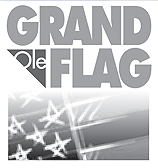 |
||||||||||||
|
July/August 2015 Patriotism, the Flag Code, and the BY MARC LEEPSON
Translated into English, this means that when you display patriotism by wearing a tee shirt, hat, jacket, or other item of apparel that has an image of the flag—or when you stretch out on your American flag beach towel or sit down in your American flag soccer chair—you are in violation of the U.S. Flag Code. The wording is vague, but the intent is clear. The federal Flag Code does not smile upon the use of the flag or its image as part of everyday citizens’ wearing apparel, including the flag lapel pin—although exceptions are made for military, fire, and police uniforms and the clothing of members of patriotic groups such as the Daughters and Sons of the American Revolution. Luckily for the millions of just plain folks who wear the pins or other items of merchandise that contain images of the flag, they will not be arrested for being in violation of the U.S. Flag Code. That’s because the Code, even though it’s part of the federal legal code, in reality is a series of guidelines on the proper use of the flag. It is not the enforceable law of the land. There are no flag police.
As for the flag lapel pin, its use became a political football at the start of the Iraq War in 2003. Bill Moyers, the PBS-TV commentator, for example, decried the sudden appearance of flag lapel pins on the suits of politicians who supported the war. “When I see flags sprouting on official lapels,” he said, “I think of the time in China when I saw Mao’s little red book on every official’s desk, omnipresent and unread.” The flag, Moyers went on to say, “belongs to the country, not to the government. And it reminds me that it is not un-American to think that war—except in self-defense—is a failure of moral imagination, political nerve, and diplomacy.” During the 2008 presidential election then-Sen. Barak Obama faced questions about his patriotism because he did not sport an American flag pin on his lapel. Charles Gibson of ABC News went so far as to ask Obama during the April 18 presidential primary debate that year if not wearing the flag pin would be “a vulnerability.” Obama answered with a spirited defense of his love of country, his iron-clad patriotism, and his opinion that the flag lapel pin question was a non-issue. He very easily also could have said that wearing a flag lapel pin apparently is against the U.S. Flag Code.
|
||||||||||||
|
|
||||||||||||
|
||||||||||||
8719 Colesville Road, Suite 100, Silver Spring. MD 20910 | www.vva.org | contact us |
||||||||||||















 Title IV, Chapter 1, Section 3 of the U.S. Flag Code deals with the commercial use of the image of the Stars and Stripes. Said section frowns upon any article “of merchandise, or a receptacle for merchandise or article or thing for carrying or transporting merchandise upon which shall have been printed, painted, attached, or otherwise placed a representation of” the flag to “advertise, call attention to, decorate, mark, or distinguish the article or substance on which so placed.”
Title IV, Chapter 1, Section 3 of the U.S. Flag Code deals with the commercial use of the image of the Stars and Stripes. Said section frowns upon any article “of merchandise, or a receptacle for merchandise or article or thing for carrying or transporting merchandise upon which shall have been printed, painted, attached, or otherwise placed a representation of” the flag to “advertise, call attention to, decorate, mark, or distinguish the article or substance on which so placed.”